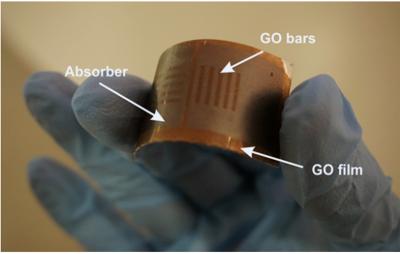Researchers at Swinburne, the University of Sydney and Australian National University have collaborated to develop a solar absorbing, ultra-thin graphene-based film with unique properties that has great potential for use in solar thermal energy harvesting.

The 90 nanometre material is said to be a 1000 times finer than a human hair and is able to rapidly heat up to 160°C under natural sunlight in an open environment.
- thermophotovoltaics (the direct conversion of heat to electricity)
- solar seawater desalination
- infrared light source and heater
- optical components: modulators and interconnects for communication devices
- photodetectors
- colorful display
- It could possibly lead to the development of ‘invisible cloaking technology’ through developing large-scale thin films enclosing the objects to be ‘hidden’.
The researchers have developed a 2.5cm x 5cm working prototype to demonstrate the photo-thermal performance of the graphene-based metamaterial absorber. They have also proposed a scalable manufacturing strategy to fabricate the proposed graphene-based absorber at low cost.
This is among many graphene innovations in our group, says Professor Baohua Jia, Research Leader, Nanophotonic Solar Technology, in Swinburne’s Center for Micro-Photonics.
In this work, the reduced graphene oxide layer and grating structures were coated with a solution and fabricated by a laser nanofabrication method, respectively, which are both scalable and low cost.
ââOur cost-effective and scalable graphene absorber is promising for integrated, large-scale applications that require polarisation-independent, angle insensitive and broad bandwidth absorption, such as energy-harvesting, thermal emitters, optical interconnects, photodetectors and optical modulators, says first author of this research paper, Dr Han Lin, Senior Research Fellow in Swinburne’s Center for Micro-Photonics.
Fabrication on a flexible substrate and the robustness stemming from graphene make it suitable for industrial use, Dr Keng-Te Lin, another author, added.
"The physical effect causing this outstanding absorption in such a thin layer is quite general and thereby opens up a lot of exciting applications, says Dr Bjorn Sturmberg, who completed his PhD in physics at the University of Sydney in 2016 and now holds a position at the Australian National University.
The result shows what can be achieved through collaboration between different universities, in this case with the University of Sydney and Swinburne, each bringing in their own expertise to discover new science and applications for our science, says Professor Martijn de Sterke, Director of the Institute of Photonics and Optical Science.
Through our collaboration we came up with a very innovative and successful result. We have essentially developed a new class of optical material, the properties of which can be tuned for multiple uses.

